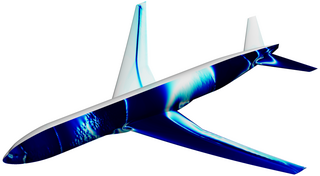
In quantum physics, a quantum fluctuation is the temporary random change in the amount of energy in a point in space, as prescribed by Werner Heisenberg's uncertainty principle. They are minute random fluctuations in the values of the fields which represent elementary particles, such as electric and magnetic fields which represent the electromagnetic force carried by photons, W and Z fields which carry the weak force, and gluon fields which carry the strong force.
The fluctuation theorem (FT), which originated from statistical mechanics, deals with the relative probability that the entropy of a system which is currently away from thermodynamic equilibrium will increase or decrease over a given amount of time. While the second law of thermodynamics predicts that the entropy of an isolated system should tend to increase until it reaches equilibrium, it became apparent after the discovery of statistical mechanics that the second law is only a statistical one, suggesting that there should always be some nonzero probability that the entropy of an isolated system might spontaneously decrease; the fluctuation theorem precisely quantifies this probability.
The fluctuation–dissipation theorem (FDT) or fluctuation–dissipation relation (FDR) is a powerful tool in statistical physics for predicting the behavior of systems that obey detailed balance. Given that a system obeys detailed balance, the theorem is a proof that thermodynamic fluctuations in a physical variable predict the response quantified by the admittance or impedance of the same physical variable, and vice versa. The fluctuation–dissipation theorem applies both to classical and quantum mechanical systems.
The Jarzynski equality (JE) is an equation in statistical mechanics that relates free energy differences between two states and the irreversible work along an ensemble of trajectories joining the same states. It is named after the physicist Christopher Jarzynski who derived it in 1996. Fundamentally, the Jarzynski equality points to the fact that the fluctuations in the work satisfy certain constraints separately from the average value of the work that occurs in some process.
The Green–Kubo relations give the exact mathematical expression for a transport coefficients in terms of the integral of the equilibrium time correlation function of the time derivative of a corresponding microscopic variable :

Denis James Evans, is an Australian scientist who is an Emeritus Professor at the Australian National University and Honorary Professor at The University of Queensland. He is widely recognised for his contributions to nonequilibrium thermodynamics and nonequilibrium statistical mechanics and the simulation of nonequilibrium fluids.
The two-stream instability is a very common instability in plasma physics. It can be induced by an energetic particle stream injected in a plasma, or setting a current along the plasma so different species can have different drift velocities. The energy from the particles can lead to plasma wave excitation.

In fluid dynamics, turbulence modeling is the construction and use of a mathematical model to predict the effects of turbulence. Turbulent flows are commonplace in most real-life scenarios. In spite of decades of research, there is no analytical theory to predict the evolution of these turbulent flows. The equations governing turbulent flows can only be solved directly for simple cases of flow. For most real-life turbulent flows, CFD simulations use turbulent models to predict the evolution of turbulence. These turbulence models are simplified constitutive equations that predict the statistical evolution of turbulent flows.
In theoretical physics, thermal quantum field theory or finite temperature field theory is a set of methods to calculate expectation values of physical observables of a quantum field theory at finite temperature.
In quantum field theory and statistical mechanics, the Hohenberg–Mermin–Wagner theorem or Mermin–Wagner theorem states that continuous symmetries cannot be spontaneously broken at finite temperature in systems with sufficiently short-range interactions in dimensions d ≤ 2. Intuitively, this means that long-range fluctuations can be created with little energy cost, and since they increase the entropy, they are favored.

The viscosity of a fluid is a measure of its resistance to deformation at a given rate. For liquids, it corresponds to the informal concept of "thickness": for example, syrup has a higher viscosity than water. Viscosity is defined scientifically as a force multiplied by a time divided by an area. Thus its SI units are newton-seconds per square meter, or pascal-seconds.

A liquid is a nearly incompressible fluid that conforms to the shape of its container but retains a nearly constant volume independent of pressure. It is one of the four fundamental states of matter, and is the only state with a definite volume but no fixed shape.
In statistical mechanics, the Lee–Yang theorem states that if partition functions of certain models in statistical field theory with ferromagnetic interactions are considered as functions of an external field, then all zeros are purely imaginary. The first version was proved for the Ising model by T. D. Lee and C. N. Yang. Their result was later extended to more general models by several people. Asano in 1970 extended the Lee–Yang theorem to the Heisenberg model and provided a simpler proof using Asano contractions. Simon & Griffiths (1973) extended the Lee–Yang theorem to certain continuous probability distributions by approximating them by a superposition of Ising models. Newman (1974) gave a general theorem stating roughly that the Lee–Yang theorem holds for a ferromagnetic interaction provided it holds for zero interaction. Lieb & Sokal (1981) generalized Newman's result from measures on R to measures on higher-dimensional Euclidean space.

In quantum chaos, a branch of mathematical physics, quantum ergodicity is a property of the quantization of classical mechanical systems that are chaotic in the sense of exponential sensitivity to initial conditions. Quantum ergodicity states, roughly, that in the high-energy limit, the probability distributions associated to energy eigenstates of a quantized ergodic Hamiltonian tend to a uniform distribution in the classical phase space. This is consistent with the intuition that the flows of ergodic systems are equidistributed in phase space. By contrast, classical completely integrable systems generally have periodic orbits in phase space, and this is exhibited in a variety of ways in the high-energy limit of the eigenstates: typically, some form of concentration occurs in the semiclassical limit .
Multi-particle collision dynamics (MPC), also known as stochastic rotation dynamics (SRD), is a particle-based mesoscale simulation technique for complex fluids which fully incorporates thermal fluctuations and hydrodynamic interactions. Coupling of embedded particles to the coarse-grained solvent is achieved through molecular dynamics.
Kyozi Kawasaki was a Japanese physicist. His research interests include chemical physics and statistical mechanics. In 2001, Kawasaki was awarded the Boltzmann Medal for "his contribution to our understanding of dynamic phenomena in condensed matter systems, in particular the mode-coupling theory of fluids near criticality, and nonlinear problems, such as critical phenomena in sheared fluids and phase separations".
Ezechiel Godert David "Eddie" Cohen was a Dutch–American physicist and Professor Emeritus at The Rockefeller University. He is widely recognised for his contributions to statistical physics. In 2004 Cohen was awarded the Boltzmann Medal, jointly with Prof. H. Eugene Stanley. Cohen's citation read "For his fundamental contributions to nonequilibrium statistical mechanics, including the development of a theory of transport phenomena in dense gases, and the characterization of measures and fluctuations in nonequilibrium stationary states."
An important class of non-Newtonian fluids presents a yield stress limit which must be exceeded before significant deformation can occur – the so-called viscoplastic fluids or Bingham plastics. In order to model the stress-strain relation in these fluids, some fitting have been proposed such as the linear Bingham equation and the non-linear Herschel-Bulkley and Casson models.

Sriram Rajagopal Ramaswamy is an Indian physicist. He is a professor at the Indian Institute of Science, Bangalore, and previously the director of the Tata Institute of Fundamental Research (TIFR) Centre for Interdisciplinary Sciences in Hyderabad.
Stochastic thermodynamics is an emergent field of research in statistical mechanics that uses stochastic variables to better understand the non-equilibrium dynamics present in many microscopic systems such as colloidal particles, biopolymers, enzymes, and molecular motors.







